Miami City Ballet bursts into Lincoln Center.
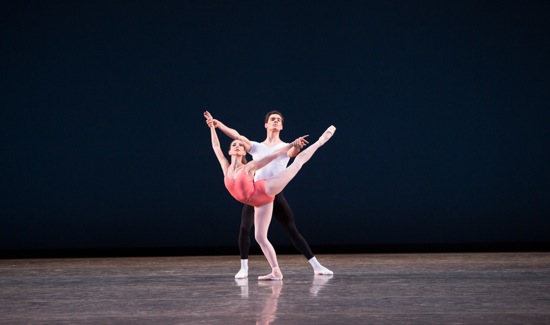
Ashley Knox and Jovani Furlan of Miami City Ballet in George Balanchine’s Symphony in Three Movements. Photo: Sasha Iziaev
Ten years ago this summer, Miami City Ballet performed at Jacob’s Pillow. This is what I wrote in the Village Voice: “Miami City Ballet’s dancers tear into Balanchine’s works with such appetite for speed and scale that you wonder how they stay in control. Their legacy is clear. They came to Balanchine through Miami’s artistic director Edward Villella, a former New York City Ballet dancer. It’s as if they’ve each been given a genetic implant encoded with his verve and attack. . . Words like plunge, strike, and slice come to mind. The women swing their legs up and the gesture seems to begin somewhere in the middle of their backs.”
I tamed those remarks by noting, “But Villella the dancer wasn’t all brash charm. He had class, musicality, and subtlety,” and noted also that he brought former NYCB colleagues in to help him in staging Agon and Rubies from Jewels. Now, Lourdes Lopez, another ex-NYCB principal dancer, is MCB’s artistic director, and at the performance I attended during the company’s brief season (presented by the Joyce Theater at the former New York State Theater, NYCB’s home), Villella was in the audience, where he could see Symphony in Three Movements, an exhilarating Balanchine-Stravinsky ballet that suggests an athletic meet in outer space, and one in which he memorably danced on the opening night of the epochal 1972 Stravinsky Festival.
What I said about the performing style in 1996 is true today, in spades. Miami City Ballet is a larger company, and it has matured and broadened its range. With no loss of precision, the dancers make full-spirited performing look as if it came from within. The audience, with a number of its Miami supporters swelling the crowd, applauded the minute the curtain rose on Symphony in Three Movements’ diagonal line of sixteen pony-tailed women in white leotards looking as exactly placed and posed as any Rockettes. When Kleber Rebello, the first man to appear onstage, bursts into a tremendous leap, you can imagine he’s had a shock of delight at seeing these vigorous, disciplined females.
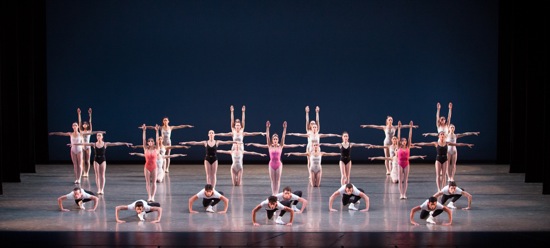
The final tableau of Balanchine’s Symphony in Three Movements. Photo: Sasha Iziaev
Every time I see a work as brilliant as this, I discover new things in it. For instance, Balanchine played all kinds of games with an often-repeated jump that travels sideways, with the dancers’ legs pressed together and bent at the hips and knees. Sometimes the five ensemble men give their partners a boost and we see the same position a few feet higher off the ground. Jumping in that way can also suggest vaulting over a stretched rope, but Rebello and his spirited partner, Natalia Arja, turn their jumps into a conversation, or a friendly competition.
During the first section of Symphony in Three Movements, I also notice how Balanchine occasionally plays games with circles. The dancers seem not to be forming and traveling in one, then are, then suddenly are. In the most remarkable one, groups of dancers are wheeling in one direction, while Patricia Delgado is circling in the opposite direction within their ranks, doing piqué turns as she goes.
Stravinsky and Balanchine are invested in speed and sharpness in this opening movement, and the feet of the third featured couple, Ashley Knox and Jovani Furlan, fairly fly. Sometimes Knox, while dancing up a storm, peers at her own feet as if to make sure they’re doing what she’s demanding of them.
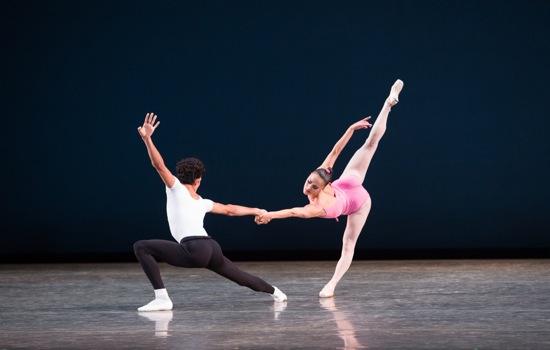
Patricia Delgado and Renan Cerdeiro in Balanchine’s Symphony in Three Movements. Photo: Sasha Iziaev
The second movement is a prolonged duet. Delgado and Renan Cerdeiro perform it more sensuously than I’ve ever seen it done. Their maneuvers with angular, linking arms; flipping hands; and nuzzling heads, while pressed together (his front to her back), seem less a test of difficult challenges than a playful game. The duet is both courtly and thoroughly contemporary, with flexed feet as well as pointed ones, and more angles than curves (even though Delgado dances with a suggestion of sinuousness that’s very seductive). For the first time, watching the duet, I caught a whiff of a duet that both Balanchine and Stravinsky grew up with: the dance of Puss in Boots and the White Cat in the Tchaikovsky-Petipa Sleeping Beauty.
By the end of MCB’s Symphony in Three Movements you’re exhilarated. Led by the company’s principal conductor, Gary Sheldon, the on-loan New York City Ballet Orchestra plays the music bracingly. The dancers make the complexity of the patterns and the powerful whirl of legs and arms as clear and driven as the workings of a giant machine, but without ever looking mechanical. If you’ll forgive my adding to an already suspect comparison by saying that, somehow each one of them is in the driver’s seat and having a fine time.
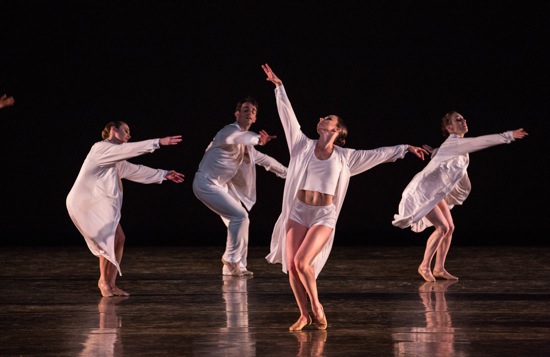
Four members of Miami City Ballet in Twyla Tharp’s Sweet Fields. Photo: Daniel Azoulay
The patterns are far simpler in the second work of MCB’s Program A. Twyla Tharp’s 1996 Sweet Fields takes its tone from the music to which it’s set: a selection of hymns by the 18th-century American composer William Billings, Shaker songs, and others from the books known known as the Sacred Harp. The fervent voices rise without instrumental accompaniment. Tharp has responded to the innocence of some of the songs and their uncomplicated vision of the delights of heaven that the virtuous may aspire to, as well as to the dangers that lie ahead before the River Jordan is crossed. The dancers walk in solemnly to begin a section and exit in the same way, as if they’ve said their piece in church. Jennifer Tipton’s lighting gives the stage a sunny-day freshness, and Norma Kamali’s costumes enhance the choreography. Long, open white coats over stylized underwear flair and float in the wake of the movement.
That movement is often simple (or deceptively so). In small groups or larger ones, the twelve dancers often skip in a circle or other formation—not big, strenuous skips; low, weighted ones, sometimes with an extra little hop. They lightly clap their hands or swirl them around each other as if molding something. “I’ll take nimble steps, I’ll be David,” sing the women’s voices, during “Come Life, Shaker” life, while Leigh-Ann Esty, Samantha Hope Galler, Nicole Stalker, Zoe Zien, and Knox (minus the cast’s sixth woman, Rebecca King) dance out that biblical exhibition in their own naïve way. Men’s voices accompany Didier Bramaz, Michael Sean Breeden, Andre Chagas, Ariel Rose, and Chase Swatosh with “Virgins Clothed in a Clean White Garment” (“Here is the fold, and the lambs all feeding—/On this green we’ll skip and play!”). But there’s nothing cute or childish in Tharp’s choreography, and the dancers perform with dedication and clarity, their white coats flying out like would-be wings. Rose delivers the piece’s final solo statement eloquently.
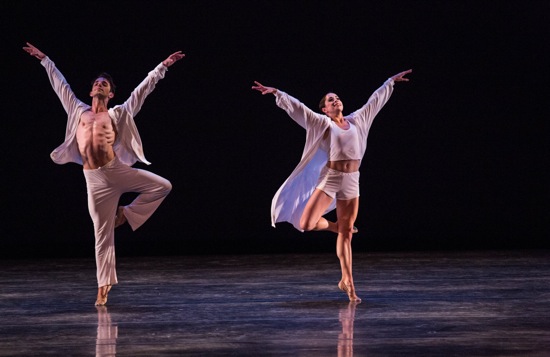
Michael Sean Breedon and Leigh-Ann Esty in Twyla Tharp’s Sweet Fields. Photo: Daniel Azoulay
One brilliant image on Tharp’s part gently teases at the images of death that crop up in the songs. Billings’s “Chesterfield” begins with these lines: “Death may dissolve my body now,/ And bear my spirit home;/ “ Why do my minutes move so slow,/ Nor my salvation come?” Tharp has set this as a funeral procession with one man borne high, stiff and supine, by his companions (the men listed above plus Bradley Dunlap). But as they walk slowly along, a man periodically slips out from under the burden to move alone beside it; then he returns, and another has a moment of private expression. The man being carried may become a carrier as another takes his place as the corpse. The process becomes more and more perilous, but the bearers’ steadfastness and gravity never falter, even at the end, when the stiff body is tossed and turned and caught again (a woman has slipped into the procession for this). At any moment, any one of us may die, does die, yet we soldier on.
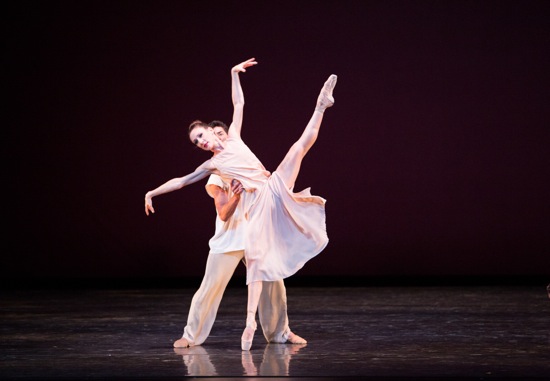
Tricia Albertson and Kleber Rebello in Alexei Ratmasky’s Symphonic Dances. Photo: Sasha Iziaev
The dancers who formed a loving community of Sweet Fields enter more turbulent territory in Alexei Ratmansky’s Symphonic Dances, set to Sergei Rachmaninoff’s suite of the same name. What emerges from orchestra bit may be bombastic, threatening, impassioned. It hints at military marches. It embarks on a dissonant waltz. A long silence is followed by a crash. And Ratmansky both vexes and entrances us with what seem to be fragments of narrative that we may not be expected to understand. Coming and going, rushing about, and dancing strenuously, the twenty-four dancers seem always watchful. What’s coming from that direction? What are they doing? This is a ballet, and what they are mostly doing is dancing with the expected virtuosity, but relationships keep boiling up within it.
The costume changes tell us something (designs by Adeline André and Istvan Dohar). In the beginning the dancers wear simple dresses, shirts and trousers in various colors. For what must be a ballroom scene, the women wear big, billowing, nearly shapeless confections of tulle or net in bright colors. They look like butterflies when their well-dressed partners lift them into the air. Later, their outfits—simple again— are in more neutral colors. In front of what looks like a distantly threatening sky (lighting by Mark Stanley), small dramas develop. You can’t be sure whether Renato Penteado is fighting with Kleber Rebello or guiding him like a tough parent. Rebello wears a white leotard with a spidery scrawl of black on the front. Later, all the men have that symbol on the backs of their attire. Later still, Nathalia Arja dances in a white leotard with a red scrawl on it.
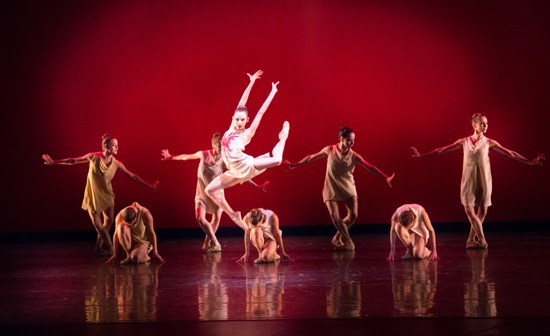
Nathalia Arja and seven Miami City Ballet women in Alexei Ratmansky’s Symphonic Dances. Photo: Sasha Iziaev
For a while, two women in blue-green dresses (Jeanette Delgado and Tricia Albertson) seem both joined at the hip and antagonistic. During the waltz scene, men may carry one of them away while the other watches. There are moments that signal jealousy or rejection. Once, one of them is left curled up on the floor as others race by, and when they appear costumed differently and dancing with the other women, you have to forget about wondering who they were. When partners separate, one may be swept into a departing crowd.
Amid the ingenious flurries of dancing, Ratmansky’s gift for expressive form stands out with particular beauty in one scene. Rebello and Nathalia Arja are engaged in a duet; others stand in a semi-circle watching. One or two women briefly echo an aspect what the couple is doing and are then replaced by someone else, and so on. So the couple keeps acquiring these ever-shifting shadows. You might wonder, are these women imitating what they can of what they see? Is this a desire to be part of this romande? An affirmation of the relationship between the lovers? Whatever Ratmansky is saying (or derived from the music), it’s strangely moving.
I regret that I was unable to see more than one program during Miami City Ballet’s seven-performance season in New York. So I missed the company in Balanchine’s Serenade and Bourrée Fantasque plus the ballets that Justin Peck and Liam Scarlett made for them. This one program, however, trumpeted the dancers’ sensitivity, virtuosity, versatility, and their ability to perform with one another in ways that enhance every step they take.

Beautiful descriptive review, as always. Alas, I was hoping to read of Simone Messmer’s (hopefully) triumphant return to NY. I write about San Francisco Ballet, where she was a beautiful dancer after her ABT career, but not a good ‘fit’, for various reasons. She has finally found her ballet home at MCB, is being appreciated for her marvelous gifts, and I’m sorry you missed the programs she danced in.
Thank you Deborah for your fine, and as always, highly descriptive review of MCB. I agree with you completely — this is a wonderful company of exciting dancers. I’ve seen them twice in Miami. They were good then and are even better now.
I was able to see two programs, and I regret that you didn’t also get a chance to see Bourree Fantasque again. I still have very fond, and clear memories of the original production, with LeClercq, Robbins, Tallchief, and most vividly, Janet Reed, flying high in the concluding Fete Polonaise.